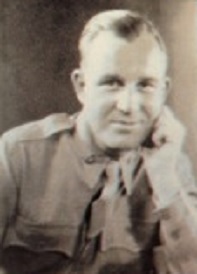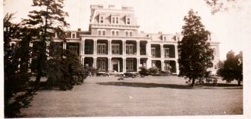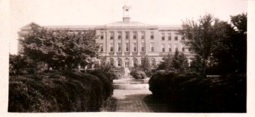Editor’s Note: Dr. James Spencer Dryden passed away on June 14, 2016, at the age of 106. Dr. Dryden worked at the Soldiers’ Home during World War II. In the fall of 2013 he shared with us his recollections of the Cottage and the Soldiers’ Home during that era. This article first appeared in the Fall 2013 Cottage newsletter.
James Spencer Dryden, pictured here in 1941. Courtesy of the Dryden Family.
Several months before the attack on Pearl Harbor, I was stationed at Walter Reed [Army Medical Center]. General Marietta was the Commanding Officer for the entire Medical Corps headquartered at Walter Reed. He had been the physician for General Pershing during World War I. He foresaw that Walter Reed would have space complications if the U.S. became involved in [World War II]. When Pearl Harbor was attacked, we became very focused on getting the personnel and bed space in order to receive the anticipated large influx of casualties. General Marietta asked me to set-up an eye department at the Soldiers’ Home to perform surgeries. There were about 3,000 retired non-commissioned officers living at Soldiers’ Home at that time. Most of the men were at an age for which cataracts are a very common problem and they typically came to Walter Reed for that surgery before the U.S. entered the war. The idea was that if we kept those surgeries at the Soldiers’ Home, it would free up bed space at Walter Reed for casualties of war. That’s how I came to the Soldiers’ Home.
At that time, the Soldiers’ Home was financed by having about $1.00 collected out of each serviceman’s paycheck. The residents were all Army non-commissioned officers. Most of the men had served anywhere from 25-30 years. So they had contributed a large amount of money to the Soldiers’ Home during their service. Most of the residents had reached retirement age and were too old to reenlist when war broke out — though some would have loved to reenlist. They were good, down-to-earth citizens. They were not fly-by-nights or alcoholics. They had led successful lives and contributed to society.
When I first arrived at the Soldiers’ Home, before the attack on Pearl Harbor, the Chief Medical Officer was Colonel Pipes. General Coleman was the Commanding Officer and the line of command included General Seaman, Colonel Matt Bristol, and Colonel Lynne. Colonel Bennett was the Treasurer. All the officers were in residence on the grounds. There were no schools on the grounds — everyone either had children who had grown-up and left home or who were still too young for school. I had only been there a few weeks before Colonel Pipes died suddenly of a coronary. General Coleman, who was the Commanding Officer at the Soldiers’ Home, requested that I be promoted and placed in Colonel Pipes’ position temporarily, until they could find a more senior officer for the position. I was the Chief Medical Officer for six months. My typical day involved keeping the surgery clinic going and keeping all the medical wards serviced. I had two Army and two civilian physicians working for me full-time in the hospital. That kept me pretty busy. Then they sent in Colonel John Wallace to assume the Chief Medical Officer position.
Colonel Wallace was a physician in the Army with 30 years of service at the time. When he arrived it was just a matter of transferring my duties over to him and resumed my surgery duties. My office was right across the hall from Colonel Wallace. We had a good relationship. We handled surgeries together, golfed together, and hunted together. We golfed on the grounds with General Coleman, General Seeman, and Colonel Bennett. We hunted quail on the 500 acres of Soldiers’ Home grounds. A portion of the grounds were planted with corn. There were three to four coveys of quail. Colonel Wallace had a bird dog named Don that came with us. We always arranged it so we had our backs to the neighborhood. We didn’t even need to have a license. We were probably the only people who hunted quail in the District. You couldn’t hunt anywhere else in the District at that time. (In those days the district was still controlled by the House District committee, appointed by the President.)
I lived in the Barnes Building, which was part of the same complex as the hospital on the grounds of the Soldiers’ Home. My wife and I had one whole wing on the first floor for our living quarters. Our quarters had a big front porch all down the front of the building and a big kitchen and dining room. There was a long corridor connecting to two or three bedrooms. And there were separate living quarters for live-in help. It was very comfortable. I worked in the hospital in the same complex. The hospital had a surgery observation room, where I performed many surgeries. All the teaching hospitals had them at the time. That was a common practice.
The old barracks and hospital building of the Armed Forces Retirement Home. Courtesy of the Wallace Family.
The grounds of the Soldiers’ Home were wonderful. Given that the Soldiers’ Home was on a hill, the view was particularly great. It was especially spectacular at night, when the Capital building and monuments were lit up, and during the fireworks on the Fourth of July.
The Soldiers’ Home was fenced in with an eight-foot high wrought-iron fence. There were four points of entry. There was not much of a relationship with the neighbors and I knew very little about them. It was a good section of town where ordinary folks lived and they never gave us any problems. There was very little communications between the Soldiers’ Home and the rest of the community; we were pretty isolated.
The Soldiers’ Home would occasionally open the grounds to colleges and civic partners around the city for events. They had certain days for that and the Soldiers’ Home police would escort them for sight-seeing tours or field days. There were several bandstands on the grounds including one by the hospital complex. The resident band would play two afternoons a week. They attracted quite a gathering of people from the Soldiers’ Home. They also attracted some civilians from outside the grounds. Civilians could get permission to come in for the band music if they applied at the gate.
Lincoln’s Summer Cottage was not open to the public. The first floor had been used as a barbershop at the Soldiers’ Home for 50 years or maybe more. While I lived on the grounds, General Coleman said they wanted to clean the Cottage out and told me there was some old furniture in the attic that was not on the inventory. He was going to have it hauled away and asked me if I wanted any of it. I took two of the tables. I don’t remember where any other furniture went. There was not a whole lot of stuff. I believe it came from the attic. It had been up there so long. One of the tables had been painted a dirty gray. It looked like it was laying up there collecting cobwebs and dirt daubers for about a hundred years. You can imagine what it looked like. My wife recognized the potential so we sent the tables out to be restored while we were still living there at Soldiers’ Home. We kept them on the premises until we left. We called them the “Lincoln tables” because we knew Lincoln had lived in the Cottage. It was common knowledge there that Lincoln had lived there and I had read about it in the Soldiers’ Home records.
I entered the service as a Major and left as a Lieutenant Colonel. I lived and worked at the Soldiers’ Home for almost four years. When the war ended, I was discharged from the Army and opened a private medical practice in Washington, DC. I tried to keep up with what went on at the Soldiers’ Home after I left because I had a personal interest in it. As a matter of fact, I used to visit on a few occasions. It was good to know the current hospital personnel. I was always interested in the Soldiers’ Home. I think it was a great asset to the military service. The non-commissioned officers who lived there were well-served there.
Editor’s Notes: Dr. Dryden was asked but did not recall anything of note about a so-called “witness tree” that died around 2002 but was reportedly here when Lincoln drafted the Emancipation Proclamation. Nor did he remember anything about the other U.S. Presidents who resided on the grounds during their administrations. He also indicated that he never witnessed commemorative events at the US Soldiers’ Home National Cemetery (now the U.S. Soldiers’ & Airmen’s Home National Cemetery), visits by notable individuals or the construction or demolition of any buildings on the grounds while he was in residence. While the Home was officially desegregated in 1963, Dr. Dryden noted that segregation was not an issue while he was there, asserting that without question, everyone was treated the same at that time. After researching the two “Lincoln tables,” the findings suggest that the tables are more likely from the 1870s-80s when President Hayes or Arthur would have been in residence.
As a point of interest, Colonel Bennett’s step-grandson donated two prints to the site in 2009. Research supported that the two prints were very likely in the Cottage while the Lincolns were in residence.



